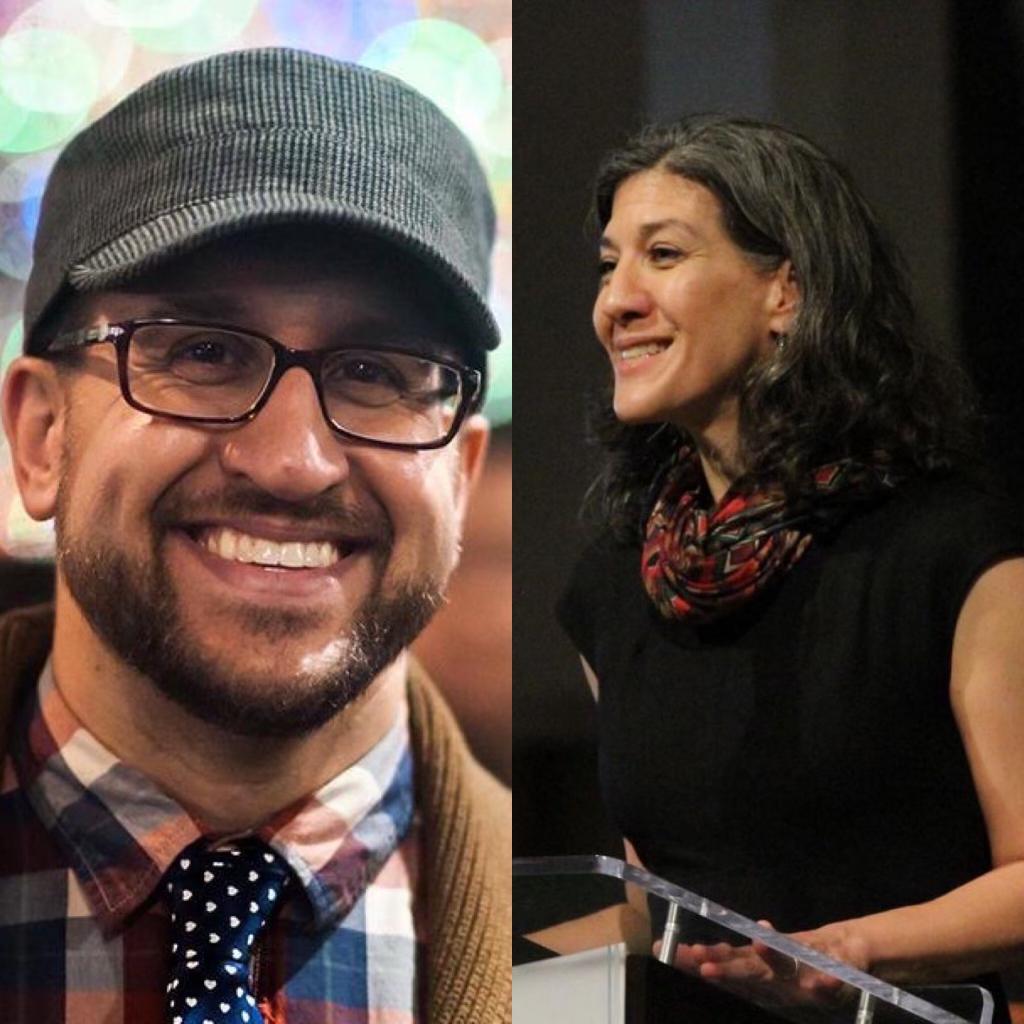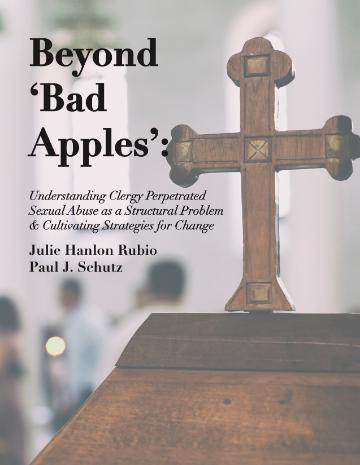Beyond ‘Bad Apples’
Understanding Clergy Perpetrated Sexual Abuse as a Structural Problem & Cultivating Strategies for Change

& Paul J. Schutz
About the Study

The primary aim of our study is to examine the ‘whys’ and ‘hows’ that enable clergy perpetrated sexual abuse (CPSA) to endure in the Catholic Church. We aim to move beyond hypotheses of “bad apple” perpetrators and investigate structural factors that perpetuate CPSA.
To achieve this aim, we first present research on what social structures are and how they operate, and—recognizing that CPSA is a specific form of sexual violence—how sexual violence operates as a structural phenomenon. This research provides a lens that enables us to see the relationship between clericalism and CPSA and provides the basis for discussing sex, gender, and power, the three prongs of our approach. We then apply this lens to the data we gathered through a survey of nearly 300 people (lay, religious, and ordained) working in ministry to illustrate concretely how structural clericalism works and how it creates conditions predisposed to the possibility of sexual violence.
By synthesizing structural analysis with data as equal parts of an overarching theory, this study offers a comprehensive exploratory primer on structural clericalism and CPSA. This work is practical at its core, oriented toward the transformation of ecclesial structures and institutions through practices of anti-clericalism.
Executive Summary
Clericalism is often cited as a key factor contributing to clergy perpetrated sexual abuse (CPSA) in the Catholic Church. But while commentators—from journalists and scholars to Pope Francis himself—acknowledge its influence, definitions of clericalism vary widely, clericalism is usually characterized as an individual phenomenon, and empirical assessments are few.
Rather than describing clericalism as an individual reality—a problem of ‘bad apples’—this study maps clericalism as a structural reality shaped by the interaction of three forces: sex, gender, and power. We define clericalism as:
a structure of power that isolates clergy and sets priests above and apart,
granting them excessive authority, trust, rights, and responsibilities
while diminishing the agency of lay people and religious.
Clericalism operates throughout the Church by offering incentives and enablements that enhance the agency of some while restricting the agency of others. It is embodied and performed by many priests and can be internalized by lay people and religious. Certain models of the priesthood, for example, enable priests to manage institutions in an authoritarian manner that suppresses the agency of lay people and religious and dissuades them from raising concerns. Anyone (ordained, religious, or lay) can be clericalist, and anyone can be anti-clericalist. Critiquing clericalism need not oppose priesthood nor demonize priests.
Our principal claim is that clericalism is best viewed as a structural reality rather than an individual vice. This report offers a comprehensive theoretical lens for analyzing clericalism as a structure and discusses findings from an original survey of ecclesial ministers, whose insights enable us to describe how clericalism functions in ecclesial life. Our approach is rooted in sociological theories of power, gender, and sexual violence. This literature points away from individual pathologies and toward analyses of cultures and environments that contribute to sexual violence, including CPSA. Addressing sexual violence in the Church requires that we analyze and dismantle structural clericalism in its essential elements: sex, gender, and power.

Our key findings are as follows:
- With respect to sex, clericalism is enabled by a lack of healthy sexual integration and inadequate sexual formation in schools of ministry and compounded by a culture of silence and repression. According to our data, a lack of adequate human formation impedes development of healthy sexual integration for priests and lay people. Because of this lack of sexual integration, many priests are unable to connect in authentically vulnerable ways and sometimes neglect appropriate boundaries. This constitutes a de facto setting apart of the priest because of a gap in his ability to navigate his existence as a celibate, but sexual, person. A lack of spaces for open discussion of sexuality compounds the problem and extends its reach in ecclesial spaces.
- With respect to gender, clericalism manifests through the performance of harmful forms of masculinity, which research links to domination and violence. According to our data, consciousness of gender construction is generally low, and many still presume a view that perpetuates male privilege. Priestly formation programs rarely provide opportunities for meaningful interaction with lay people and religious, especially women. Priests also receive little education in gender studies and lack familiarity with constructions of masculinity that isolate them and restrict their ability to authentically connect with those they serve.
- With respect to power, clericalism operates as an invisible backdrop for ecclesial life that sets clergy above and apart from non-ordained members of the Church. According to our data, the clericalist exercise of power manifests both in authoritarian and disorganized management styles and in theologies of the priesthood that center on the perceived authority and status of ordained ministers. It manifests to a lesser degree in theologies that view priestly authority as service of the Church. It is enabled by priests’ limited training and their lack of experience working alongside and empowering lay people.
- Clergy sexual abuse cannot be attributed to some “bad apples” and must be analyzed in relationship to the whole of ecclesial life (e.g. using structural analysis). Though our study cannot show that clericalism causes CPSA, our nearly 300 respondents (a unique group of priests, deacons, women religious, and lay ecclesial ministers with decades of experience working in Church settings) stated that CPSA is rooted not in individual pathologies but in systemic problems related to sex, gender, and power. Jesuit institutions generally appear to be ahead of diocesan seminaries and can provide healthier models for formation and ministry.
- Alternatives to clericalism—what we term “anti-clericalism”—include collaborative approaches to ministry that empower lay people to use their gifts and talents, and strategies that foster healthy sexual integration and raise consciousness about harmful forms of masculinity and femininity linked to patriarchal constructions of gender. Rooted in the Gospel and contemporary theologies of the priesthood, anti-clericalism is already being practiced among some priests and lay people and offers hopeful signs of resistance and transformation.
While effective steps have been taken to create safe environments, educate adults and children, and improve reporting in Catholic institutions, structural work to address the root causes of CPSA remains to be done. Our report concludes with recommendations for developing alternatives to structural clericalism, which we hope will contribute to a reduction in CPSA.
Funding Information

This study was funded by a generous grant from Fordham University as part of Taking Responsibility: Jesuit Educational Institutions Confront the Causes and Legacy of Sexual Abuse. Co-sponsored by Fordham’s Department of Theology and Francis and Ann Curran Center for American Catholic Studies, Taking Responsibility advances research regarding the protection of children, youth, and vulnerable persons in Jesuit institutions of education. Key goals for the grant include:
- support for rigorous, focused investigations into aspects of clerical sexual abuse as they have manifested at Jesuit institutions;
- the production of resources aimed at assisting Jesuit administrators, faculty, staff, students, and others to examine the causes, history, and consequences of sexual abuse, as well as ethical considerations about our responsibility in the present day;
- the facilitation of ongoing conversation, including through regular online and offline meetings for consultation and study and a major conference in Spring 2022; and
- the development of a partner network of Jesuit educational institutions through which this work can continue.
More information about Taking Responsibility and projects at other Jesuit institutions can be found here.
